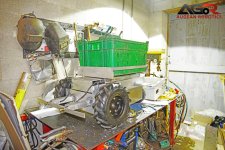what a wonderful thread, fascinating to me because if the OP thinks her operation is small, well I'm the smallest of them all at 43 trees, not 430 or 4300. But I prune, and pick (new orchard, got all of one apple last year), and spray constantly (coastal NC is a terrible place for an orchard) as I learned growing up on a farm in PA with a fruit orchard. I look at these pictures of material handling huge amounts of apples and I smile and only think "I wish".

A robotic cart is likely to work best in a very controlled environment where the crops are almost planted to take advantage of it. I would go talk to the folks growing veggies in the Central Valley of California and see what they do. Irrigation is very high tech today, with water sensors testing the ground and only applying water when needed. Those who have already invested in high tech methods might be intrigued by this cart, but to make it work, and be cost effective, I think it needs to be integrated into the process. Otherwise a UTV or garden tractor with a big cart would sure handle the small operations, and then those big bins as Aaron has pointed out for the larger operations. If those fruit growers find those bins to be the right maximum size desirable, why would they consider an alternative much, much smaller? I think you might have to skip fruit and maybe consider a much lighter crop like lettuce perhaps? Otherwise 250 pounds doesn't haul much product.
Now that marijuana growing is legal so many places, how about a robotic cart for the greenhouse operations on that seriously expensive product?
I'm only partially kidding...
Now you can always make a rich man's toy. Lots of talking robots and fun stuff out there, something for the Hammacher Schlemmer catalog.
But I think you have sat down at the end of the day and thought you were really wasting time doing certain repetitive motions in your orchards.
The challenge is in most of the US, particularly here, migrant workers come through and do it all for a known fixed cost.
That may be the issue in California also.
I grew up and lived most of my life outside of New Hope, not too far East of you. A difficult area to get good help because none of the teenagers today want to work basically, too busy texting and driving their BMW's. Maybe not quite so bad out where you are but I can understand why you need some labor alternatives. I think the only real benefit of such a lightweight vehicle/cart is that it would certainly tread lightly. Maybe that feature would appeal to some.
